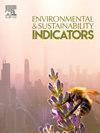Relationships between mean species abundance (MSA) and potentially disappeared fraction of species (PDF) are consistent but also uncertain
IF 5.4
Q1 ENVIRONMENTAL SCIENCES
引用次数: 0
Abstract
The potentially disappeared fraction of species (PDF) and the loss in mean species abundance (MSA) are two commonly used indicators to quantify losses in local biodiversity integrity associated with production and consumption of goods and services (biodiversity ‘footprints’). However, it is unclear to what extent these two indicators align. Here we explore if and how losses in MSA are related to PDF based on both simulated data from virtual species communities and empirical pairwise comparisons of impacted and reference communities (n = 19,891). We find a significant positive but uncertain relationship between MSA loss and PDF. Based on the empirical data, PDF leaves about half of the variance in MSA loss unexplained. Our results further highlight that MSA loss and PDF reveal distinct aspects of community change. At a PDF of zero, we find an average decline in MSA of 0.20 (95% CI = 0.09–0.42), reflecting that abundance loss precedes species extinction and that MSA loss is a more sensitive indicator of biodiversity change than PDF, particularly at low PDF values. Given the intrinsic differences between the indicators and the large residual heterogeneity in the relationship between them, we conclude that MSA loss and PDF provide complementary information. We recommend either making an informed choice for one of the indicators in view of the goals and scope of the application, or using them in parallel for a more comprehensive assessment.
求助全文
约1分钟内获得全文
求助全文
来源期刊

Environmental and Sustainability Indicators
Environmental Science-Environmental Science (miscellaneous)
CiteScore
7.80
自引率
2.30%
发文量
49
审稿时长
57 days
 求助内容:
求助内容: 应助结果提醒方式:
应助结果提醒方式:


